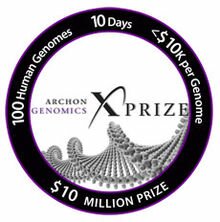 The Archon X Prize for Genomics offers a $10 million prize to to the first team that can sequence 100 human genomes within 10 days or less at a total cost of $10,000, with strict criteria for accuracy and completeness. However, given that there aren’t currently any gold standard genomes that could be used to confirm that a team has met the Prize’s requirements, and the complexity of judging the winner is far greater than for any previous award from the X Prize Foundation. To help refine the validation process, the Prize Foundation has just announced a collaboration with Nature to crowd-source ideas, which can be submitted via comments on the current plan over at Nature Precedings. If you’re interested in helping to define the state of the art in human genome construction, head over and have your say. [DM]
The Archon X Prize for Genomics offers a $10 million prize to to the first team that can sequence 100 human genomes within 10 days or less at a total cost of $10,000, with strict criteria for accuracy and completeness. However, given that there aren’t currently any gold standard genomes that could be used to confirm that a team has met the Prize’s requirements, and the complexity of judging the winner is far greater than for any previous award from the X Prize Foundation. To help refine the validation process, the Prize Foundation has just announced a collaboration with Nature to crowd-source ideas, which can be submitted via comments on the current plan over at Nature Precedings. If you’re interested in helping to define the state of the art in human genome construction, head over and have your say. [DM]
This week MIT’s Technology Review released this year’s TR50, a list of the 50 most innovative companies. Biomedical companies make a good showing, with 8 in total. Excitingly, three of these companies have been chosen for innovations in DNA sequencing technology; Complete Genomics, for developing the service approach to sequencing human genomes, Life Technologies for aquiring the new Ion Torrent machine, and Pacific Biosciences for their single-molecule sequencing machines. [LJ]
Over at Forbes, Matthew Herper pointed out the announcement of an exciting new targeted drug for cystic fibrosis that showed greater than expected results in clinical trials, as well as the announcement by Life Technologies of an impending upgrade to their Ion Torrent sequencing platform (also comprehensively dissected by Keith Robison here and here). This all sounds like good news, but Herper warned in a separate post that the implications of recent developments in genomics and pharmaceuticals might be heading towards a chaotic impact:
One tough reality is that the new methods of studying genetic variation, which look deeply at the biology of relatively small numbers of people, are at odds with the way we’ve been thinking about drugs for years, studying common medicines like cholesterol drugs in thousands or tens of thousands of patients. In many ways, what we’re set up for is a collision between genetics and large-scale studies, between innovation and cost, and between a vision of medicine that is struggling and one that is trying to create itself. It could spark lots of great new medicines for everyone. It could also be a giant mess.
Meanwhile, Duke’s Leigh Ann-Williams argued that Herper “has it wrong”, and relies on an overly narrow definition of personalised medicine. [DM]
Elaine Westwick has a long and thoughtful post exploring her experiences with both direct-to-consumer genetic testing and formal genetic counselling for breast cancer risk. She notes (fairly) that DTC genetic testing provides only a small part of a much bigger picture:
The two procedures were very different – family tree building means taking time to talk to people and hunt down information, whereas genotyping involves a click, a credit card and a consumer buzz. For those impatient, affluent and not a fan of family conversations, the computer wins hands down, but, for me, old fashioned tree building felt more meaningful. This result wasn’t as precise as a number, but it was a much more valuable in terms of personal knowledge and understanding.
It’s worth remembering that these approaches aren’t mutually exclusive: people seeking to gain a complete understanding of their own health risks can (and should) integrate across all sources of information as best they can, putting any genetic results in the context of (often far more useful) evidence from family history and lifestyle risk factors. [DM]
When you work on genome-wide association in disease, one of the most satisfying things you can see is someone taking a GWAS signal using it to learn novel biology. This is becoming increasingly common, and this week Nature Genetics has an article reporting on the work unpicking the biology of the IRGM association in Crohn’s disease. The story turns out to be surprisingly complicated, with multiple different effects acting on the gene, including a 20kb deletion of a regulatory region that changes tissue-specific expression, and a mutation that seems to change a micro-RNA binding site. I like this, as it has the right balance of confusion and understanding: enough understanding to indicate that new biology has been learned, but enough confusion to prompt new questions and experiments going forward. [LJ]








 RSS
RSS Twitter
Twitter
0 Responses to “Defining a complete genome, innovative sequencers, and the mess ahead for personalised medicine”